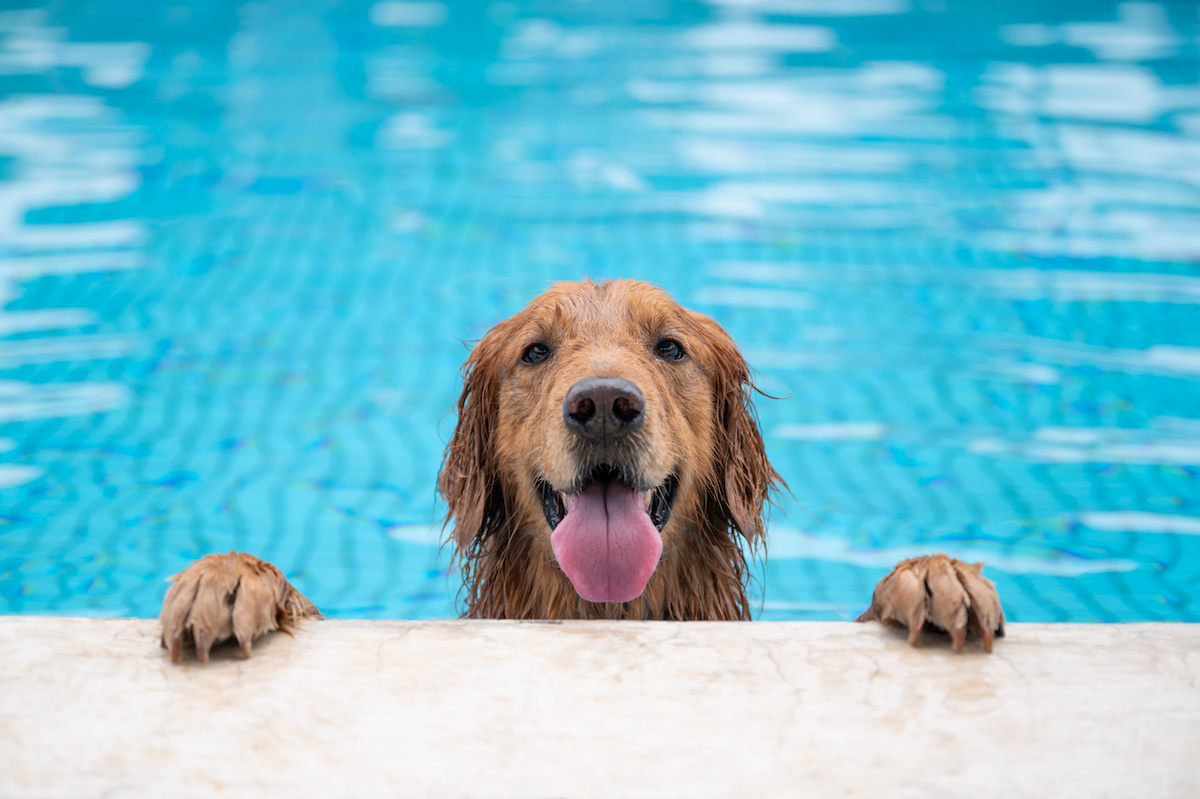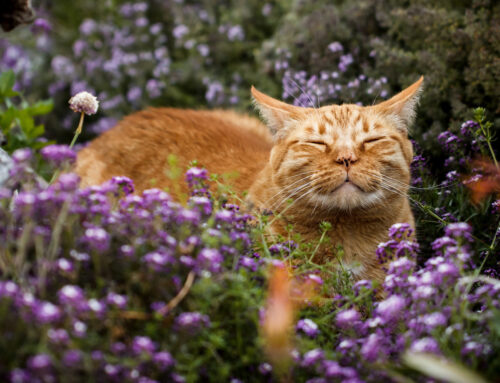Did you know that, on average, pets tend to have a higher risk of drowning than humans? It’s estimated that 5,000 family pets drown in backyard swimming pools each year compared to 4,000 humans. This is why pool safety for pets is incredibly important!
To help reduce this number, many local authorities including public parks have implemented pet-friendly swim restrictions or introduced pet-only swim times. However, these precautions are not enough to safeguard your cat or dog from the potential dangers in your own backyard.
Having a swimming pool in your backyard is a wonderful luxury during the hot summer months and it’s a treat your pet can enjoy with you as long as safety precautions are taken.
This is a comprehensive guide on how you can keep your furry friends safe in and around your swimming pool.
What is the risk for pets in swimming pools?
Swimming pools are a great way for pets and their owners to cool down during a warm day, unfortunately, they can also be dangerous.
The primary dangers associated with swimming pools include:
- Drowning
- Exposure or ingestion of pool chemicals
- Heat Stroke
Let’s explore each of these hazards a little more and discuss the best ways to prevent accidents from happening.
Drowning
Drowning is the most common cause of death related to swimming pools. Dog owners might be tempted to skim past this segment since all dogs are natural-born swimmers, right? Not necessarily.
While both dogs and cats have an instinctual ability to swim, there are a few factors that contribute to a higher risk of drowning.
- Breed- Certain breeds of dogs and cats have a more difficult time swimming. For example; breeds with flat noses or short snouts, barrel shaped bodies and short legs, or excessively long thick coats will have a more difficult time staying afloat.
- Age- Puppies and kittens may lack the coordination and muscle strength to swim very far. On the other hand, older pets may tire out more easily or become disoriented.
- Medical difficulties- Pets who suffer from vision loss, arthritis, dementia, or who are prone to seizures have a higher risk of drowning. Check your pet’s medications as well to ensure that they won’t hinder their ability to swim safely.
Even if your pet is a young, healthy swimming enthusiast, accidents can still happen. Pets can fall into the water unexpectedly and panic or tire out without warning.
How to Prevent Drowning
Now that you understand the risks associated with pet drownings, let’s discuss the ways you can prevent this tragedy from happening.
- Conduct a swim test- Swim with your pet and stay within arm’s reach until you are familiar with their abilities. If your pet seems to enjoy the water, you can practice with them until they become stronger swimmers.
- Install a safety fence and alarm- The best way to protect pets and humans from drowning is to install a safety fence with a pet-proof locking gate. Consider a pool alarm as well, which will alert you if your pet falls into the pool unexpectedly.
- Train your pet to use the stairs- While enthusiastic swimmers won’t hesitate to run and jump into a swimming pool, they won’t be able to jump out as easily. Make sure your pool has stairs or a ramp that your pet can access easily and navigate without assistance.
- Invest in a life vest- If your pet fears the water or has difficulty swimming consier purchasing a special pet-specific life vest. If they fall into the water this can keep them afloat until you can get to them.
- Be careful of entanglement- Remove pool covers, solar panels or large rafts any time your pet is near the water. They can easily become tangled or trapped underneath.
- Learn pet CPR– No matter how careful you are, accidents can happen. Learning pet CPR could save your pets life.
- Never leave your pet unattended- Even strong swimmers shouldn’t be left to swim alone. Watch pets as closely as you would watch human children when they are in or around the pool.
Pool Chemicals
Untreated pools can be a breeding ground for bacteria and algae that can be toxic to you and your pet. Unfortunately, the pool chemicals required to keep away that bacteria can also be dangerous if proper precautions aren’t taken.
When used correctly, chemically treated pools are safe to swim in and even ingest in small amounts, however full strength chlorine, bromine, and even alkaline tests can be irritating to skin and fatal if ingested.
How can you keep your pool sanitary and safe for your pets?

Using Pool Chemicals Safely
Chemicals are necessary to keep harmful bacteria and algae out of your swimming pool, but be sure to follow these tips to keep your pets safe:
- Keep chemicals locked up- While most chemicals are safe for your pet once they are properly diluted in the pool, full strength chemicals can be fatal. Designate a lockable shed or storange container to store all of your pool chemicals, cleaners and testing supplies. Don’t let your pet outside while you are using these products and lock them back up as soon as you are finished.
- Read directions carefully- Pool chemicals are designed to be diluted to safe levels. Using too much of a chemical or using the chemicals incorrectly can throw off this delicate balance and make your pet sick. Also, if you “shock” your pool, be sure to wait until chemicals levels are back to a safe level before letting your pet swim (usually about 24 hours).
- Don’t let your pet drink pool water- It’s safe for pets to ingest a small amount of pool water while swimming, but allowing them to drink large amounts of chemically treated water can lead to upset stomach, vomiting, diarrhea and even kidney failure. Keep plenty of fresh clean water nearby and direct your thirsty pets to that instead.
- Rinse your pet after swimming- Get in the habit of rinsing your pet off after a swim. This prevents chemicals from staying on their skin and fur for too long which can cause skin irriation and stomach upset from licking it off.
- Look for safer alternatives- Consult your local pool supply shop for advice on pet-friendly pool chemicals that may be safer to use with furry swim companions.
Heat Stroke
Swimming is a great way to cool off on hot days, but unfortunately spending all afternoon at the pool also means spending all afternoon in the sun which can cause heat stroke.
Heat stroke, also known as heat exhaustion, occurs when your pet’s body temperature rises above its standard range of 100 to 102.2. Dogs and cats don’t have very many sweat glands so their bodies can quickly lose it’s ability to regulate their temperature.
Heat stroke typically occurs when the temperature outside soars past 80 degrees, however, heat stroke can happen in lower temperatures if the humidity is high.
Signs of heat stroke in pets include:
- Excessive panting or drooling
- Difficulty breathing
- Vomiting or diarrhea
- Weakness, stumbling or disorientation
- Collapse
- Seizures
If your pet shows any sign of heat stroke, move them to a cool shady spot and contact your vet right away.
Preventing Heat Stroke
Heat stroke can strike quickly in the summer so follow these precautions to prevent it from happening to your pet:
- Take breaks from the sun- No matter how much fun you may be having swimming with your pet, make sure they have a cool shady area for them to escape to if the heat gets to be too much. Set up a tent or large umbrella near your pool for some instant shade.
- Stay hydrated- Dehydration can make the effects of the sun and heat much worse. Keep a fresh supply of cool water available to your pet at all times. This will also prevent your pet from drinking pool water.
- Avoid peak hours- The midday sun is the harshest, try to schedule your swims in the morning or evening when the heat is milder.
- Never leave your pet unattended- Leaving your pet unattended near the pool puts them at risk of drowning but it also might take you longer to notice when the sun becomes too much for them.
Swim Safely With Your Pet
Swimming is a great way for your pet to cool down and get some exercise this summer but if you aren’t careful swimming pools can be a hazard to your furry friends.
If you have any questions about how to keep your pet safe in and around swimming pools this summer contact the Animal Care Center!






